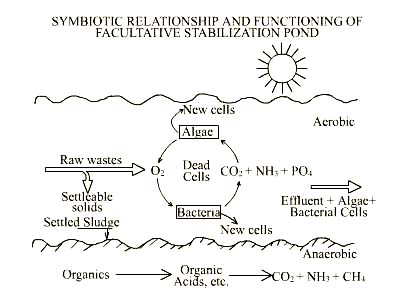Stabilization Ponds
Classification of Stabilization Ponds
Mechanism of Purification
Factors Affecting Pond Reactions
Algal Growth and Oxygen Production
Areal Organic Loading
Detention Time
Depth
Stabilization Ponds
- The stabilization ponds are open flow through basins specifically designed and constructed to treat sewage and biodegradable industrial wastes. They provide long detention periods extending from a few to several days.
- Pond systems, in which oxygen is provided through mechanical aeration rather than algal photosynthesis are called aerated lagoons.
- Lightly loaded ponds used as tertiary step in waste treatment for polishing of secondary effluents and removal of bacteria are called maturation ponds.
Classification of Stabilization Ponds
Stabilization ponds may be aerobic, anaerobic or facultative.
-
Aerobic ponds are shallow ponds with depth less than 0.5 m and BOD loading of 40-120 kg/ha.d so as to maximize penetration of light throughout the liquid depth. Such ponds develop intense algal growth.
-
Anaerobic ponds are used as pretreatment of high strength wastes with BOD load of 400-3000 kg/ha.d Such ponds are constructed with a depth of 2.5-5m as light penetration is unimportant.
-
Facultative pond functions aerobically at the surface while anaerobic conditions prevail at the bottom.They are often about 1 to 2 m in depth. The aerobic layer acts as a good check against odour evolution from the pond.
Mechanism of Purification
The functioning of a facultative stabilization pond and symbiotic relationship in the pond are shown below. Sewage organics are stabilized by both aerobic and anaerobic reactions. In the top aerobic layer, where oxygen is supplied through algal photosynthesis, the non-settleable and dissolved organic matter is oxidized to CO2 and water. In addition, some of the end products of partial anaerobic decomposition such as volatile acids and alcohols, which may permeate to upper layers are also oxidized periodically. The settled sludge mass originating from raw waste and microbial synthesis in the aerobic layer and dissolved and suspended organics in the lower layers undergo stabilization through conversion to methane which escapes the pond in form of bubbles.

Factors Affecting Pond Reactions
Various factors affect pond design:
- wastewater characteristics and fluctuations.
- environmental factors (solar radiation, light, temperature)
- algal growth patterns and their diurnal and seasonal variation)
- bacterial growth patterns and decay rates.
- solids settlement, gasification, upward diffusion, sludge accumulation.
The depth of aerobic layer in a facultative pond is a function of solar radiation, waste characteristics, loading and temperature. As the organic loading is increased, oxygen production by algae falls short of the oxygen requirement and the depth of aerobic layer decreases. Further, there is a decrease in the photosynthetic activity of algae because of greater turbidity and inhibitory effect of higher concentration of organic matter. Gasification of organic matter to methane is carried out in distinct steps of acid production by acid forming bacteria and acid utilization by methane bacteria. If the second step does not proceed satisfactorily, there is an accumulation of organic acids resulting in decrease of pH which would result in complete inhibition of methane bacteria. Two possible reasons for imbalance between activities of methane bacteria are: (1) the waste may contain inhibitory substances which would retard the activity of methane bacteria and not affect the activity of acid producers to the same extent. (2) The activity of methane bacteria decreases much more rapidly with fall in temperature as compared to the acid formers.
Thus, year round warm temperature and sunshine provide an ideal environment for operation of facultative ponds.
Algal Growth and Oxygen Production
Algal growth converts solar energy to chemical energy in the organic form. Empirical studies have shown that generally about 6% of visible light energy can be converted to algal energy.
The chemical energy contained in an algal cell averages 6000 calories per gram of algae.
Depending on the sky clearance factor for an area, the average visible radiation received can be estimated as follows: Avg. radiation= Min. radiation + [(Max. radiation - Min. radiation)x sky clearance factor]
Oxygen production occurs concurrently with algal production in accordance with following equation:
106C02 + 16NO3 + HPO4 + 122H2O + 18H+  C106H263O110N16P1 + 138O2 C106H263O110N16P1 + 138O2
On weight basis, the oxygen production is 1.3 times the algal production.
Areal Organic Loading
The permissible areal organic loading for the pond expressed as kg BOD/ha.d will depend on the minimum incidence of sunlight that can be expected at a location and also on the percentage of influent BOD that would have to be satisfied aerobically. The Bureau of Indian Standards has related the permissible loading to the latitude of the pond location to aerobically stabilize the organic matter and keep the pond odour free. The values are applicable to towns at sea levels and where sky is clear for nearly 75% of the days in a year. The values may be modified for elevations above sea level by dividing by a factor (1 + 0.003 EL) where EL is the elevation of the pond site above MSL in hundred meters.
Detention Time
The flow of sewage can approximate either plug flow or complete mixing or dispersed flow. If BOD exertion is described by first order reaction, the pond efficiency is given by:
for plug flow: Le/Li = e-k1t
for complete mixing: Le/Li = 1
1+k1t
For dispersed flow the efficiency of treatment for different dgrees of intermixing is characterized by dispersion numbers.Choice of a larger value for dispersion number or assumption of complete mixing would give a conservative design and is recommended.
Depth
Having determined the surface area and detention capacity, it becomes necessary to consider the depth of the pond only in regard to its limiting value. The optimum range of depth for facultative ponds is 1.0 - 1.5 m.
|